Content
- 1 Lupine as a siderat: when to sow and in front of what crops
- 2 Lupine varieties and its benefits as a siderat
- 3 How to plant a plant?
- 4 Siderat care
- 5 Reviews of gardeners and gardeners
- 6 Why is lupine good for soil?
- 7 Benefits of using lupine as a green manure
- 8 Types and varieties of annual lupine
- 9 Growing annual lupine
- 10 The use of annual lupine as a green manure
- 11 Why does lupine grow poorly?
Now there are many soil-improving plants on sale, and novice natural gardeners can not immediately figure out when to sow lupine as a siderat. Indeed, many green manure crops possess the properties of insecticides and fungicides, destroying parasites present in the ground (white mustard, marigolds). And some of them contribute to the alkalization of the soil and the transformation of plots of little use for a garden and vegetable garden into rather nutritious lands. Let's see what is good for the annual lupine.
Lupine as a siderat: when to sow and in front of what crops
Fans of organic farming are actively using green manure plants to improve the physical and chemical parameters of the soil in their plots.
Planting them on free plots with the aim of subsequent plowing of biological mass contributes to the improvement of the soil, increased aeration and moisture permeability, saturation with vermicompost and all nutrient compounds necessary for plant cultivation.
One of these plants is lupine - an annual from the legume family, high-yielding and unpretentious. It should be noted that lupine can also be perennial. Such varieties of flowering plants are grown in flower beds and front gardens.
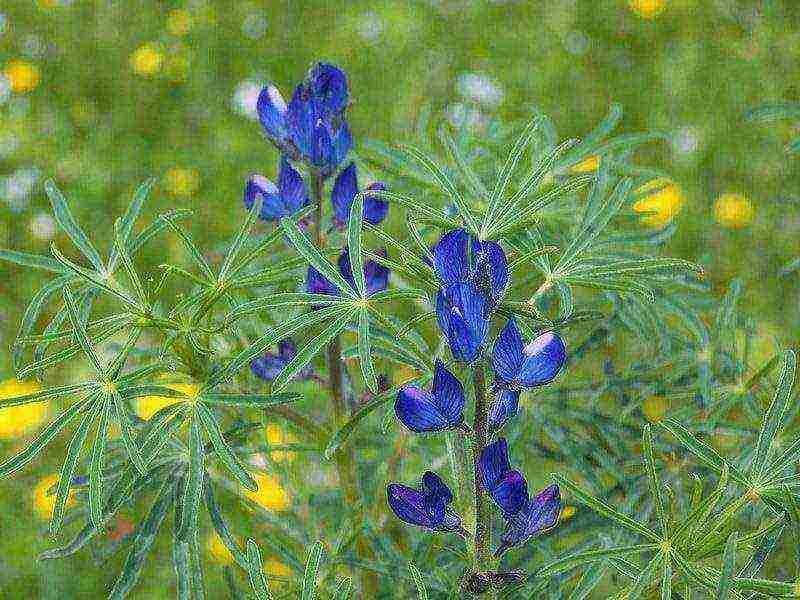
The benefits of lupine for the garden
As a siderat, one-year lupine is most often used: white, yellow and narrow-leaved. Its tap root system, penetrating into the lower soil horizons to a depth of 2 meters, is "equipped" with nodule nitrogen-fixing bacteria, which, absorbing nitrogen from the air, saturate the soil with it.
Lupine roots assimilate the subsoil layers, pulling out difficult-to-reach forms of nutrients from the lower layers and transforming them into easily digestible ones, for example, phosphorus from poorly soluble phosphates.
According to the reviews of experienced natural vegetable growers, strawberries planted after lupine, as well as nightshade and cereal crops, yield a yield that is twice the usual indicators.
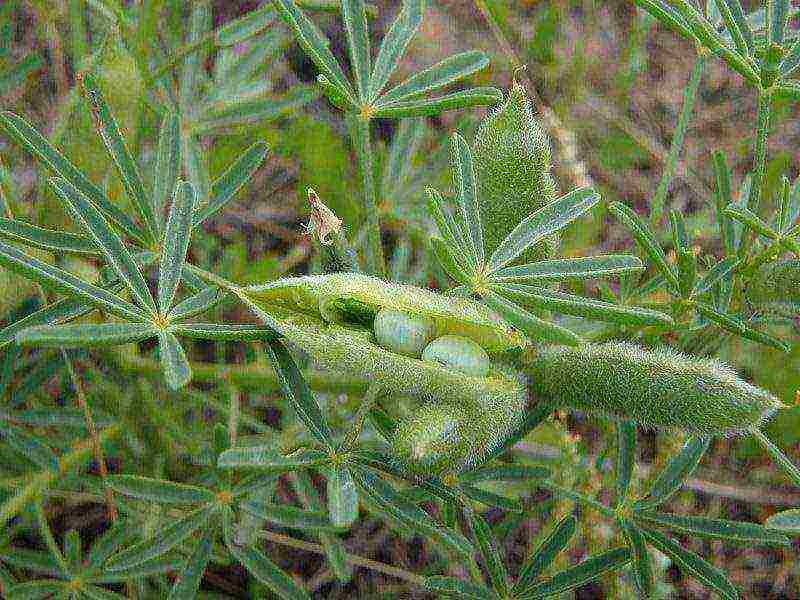
We do not recommend using lupine as a precursor for all legumes (peas, beans, peanuts, etc.), as they have common pests and diseases that accumulate in the soil. And this is not the only reason for the need to change crops in the beds - after the roots die off, colins accumulate in the soil, inhibiting the growth of plants of the same species. This is why rotations and mixed plantings are so effective for organic beds.
Lupine is able not only to loosen the soil, but also to reduce its acidity due to the presence of alkaloids, which have the ability to alkalize. The same substances scare away the wireworm, clearing the areas infected with it from the larvae of the parasite, which causes serious harm to root crops. Lupine helps to inhibit pathogens that cause diseases such as scab and root rot.
Siderat is ideal for poor and depleted soils, sandstone, sandy loam, uncultivated land. It is not recommended to sow all types of lupine in peat bogs and heavy clay areas.
It is believed that lupines are most beneficial for the garden when sown in the fall. For example, if you plan to grow potatoes in the garden next season, then lupines should be planted in September, after harvesting the previous crop.
In the spring, lupine is sown in the early stages, as soon as the soil "ripens". The seeding depth is 5 cm, on sandstones - up to 8 cm. For example, we make transverse grooves with a flat cutter, raking up last year's mulch and pour the seeds abundantly. Then we press and crush the peas with the flat side of the same plane cutter. And fill it with compost on top, crush it again and sprinkle it with sleeping coffee. Coffee cake will absorb slugs, they are already very greedy for the cotyledons of legumes and pumpkin seeds.
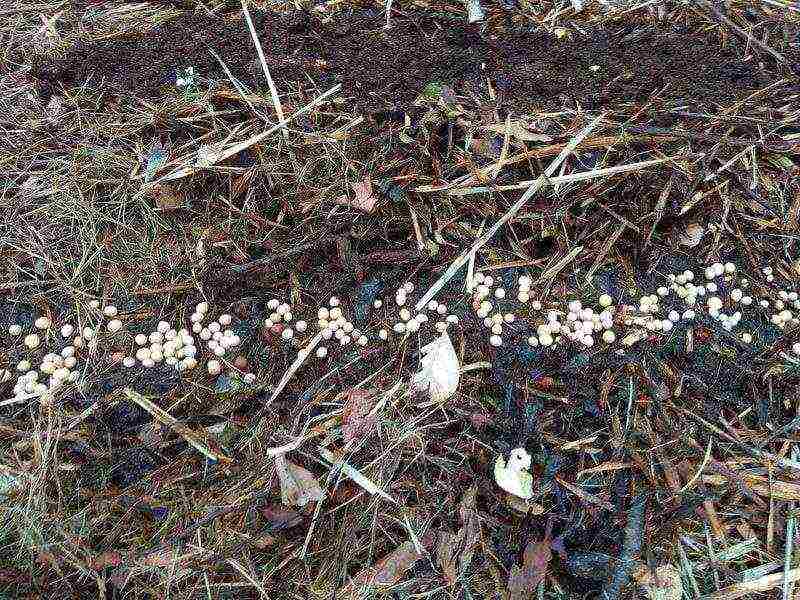
Lupine seeds germinate at + 5ºC, and the seedlings can withstand short return frosts down to -4ºC. We mow and lay the green mass on the same bed as soon as the green manure enters the budding stage. Previously, it makes no sense - it is during flowering that nodule bacteria on the roots are best developed.
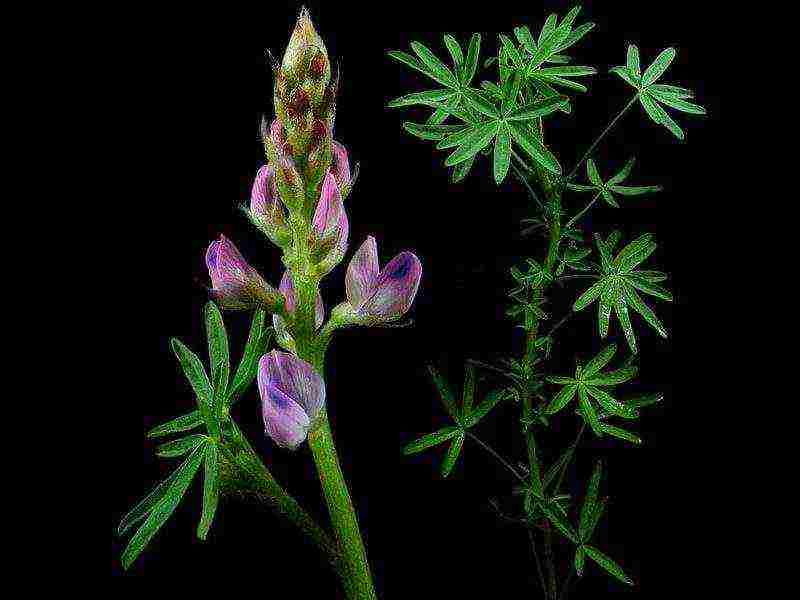
Features of lupine as a siderat
The plant is early maturing and gains the full volume of green mass in 50-55 days. At this time, the green mass is mowed, which can either be immediately embedded in the soil, or left on the site until spring, plowing after the snow has melted. Smelling, of course, is optional - you can leave greens on the surface, it will be perfectly processed by microbes and earthworms.
According to the research carried out, lupine gives about 60 t / ha of green mass. Such an amount of greenery, when decomposed in the soil, enriches it with vermicompost in an amount of up to 3 tons. The root system remaining in the ground after cutting off the upper part of the plants decomposes and saturates it with valuable substances.
Lupine seeds are sown in plowed wet soil in rows (the distance between them is from 15 to 30 cm) or densely scattered. The consumption rate of planting material is from one and a half to three kg / weaving.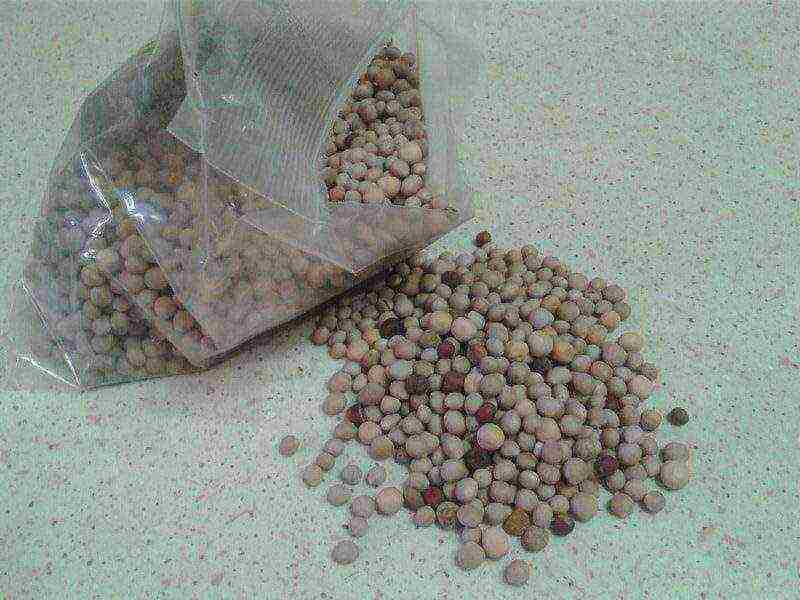
If your plot has sandy soil, from which almost all nutrients are washed out, or the productivity of nightshade crops has significantly decreased due to soil depletion, then try to increase fertility by sowing lupine before winter. Of course, he will enrich other soils with nitrogen. So feel free to start sowing in September and then select the optimal timing for your site when sowing lupine as a siderat - it not only enriches, but also structures the soil.

Every gardener is faced with the fact that after some time of using the land plot, the vitamin and nutrient reserves of the soil begin to deplete. The time is coming for its restoration, and here you can resort to one of two options - to actively apply fertilizers in the beds or simply sow them with green manure, so that they, in turn, feed the earth with all the necessary substances, simultaneously loosening it. They do not expect beautiful flowering from such plants, their task is extremely simple and understandable - to grow and saturate. But there is such a wonderful plant as lupine, which not only brings tangible benefits in the garden, but is also a pleasant sight during flowering.
Lupine varieties and its benefits as a siderat
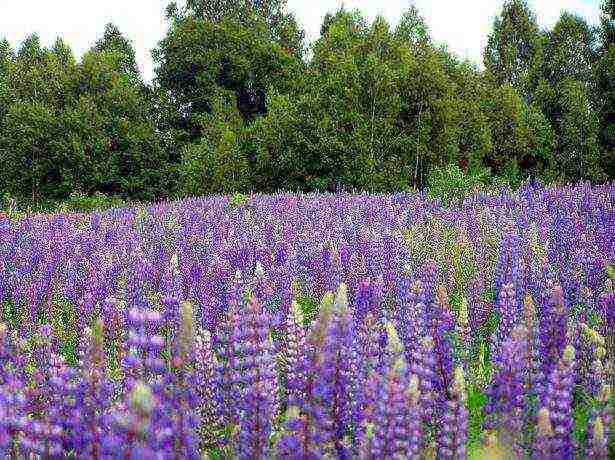
Lupine is easy to find in the wild - large fields can be overgrown with this interesting plant in a short time.
Of course, lupine is one of the first that comes to mind, as soon as it comes to siderates. But not everyone is ready to choose him as an assistant. Most likely, the reason lies in the lupine's ability to root perfectly in the chosen place (the roots go almost two meters deep) and its vitality. However, if you look closely at its merits, then fears and doubts can quickly evaporate. And that's why:
- The roots really go deep into the depths (1.5 - 2 meters), which allows the plant to absorb monohydrogen phosphates (mineral fertilizers) and raise them higher, delivering them to the upper layers of the soil. At the same time, the reserves of nutrients in the sod layer remain intact, that is, the lupine does not deplete the soil.
- Lupine perfectly loosens the soil, supplies it with oxygen, and this is a good guarantee of healthy growth and development of vegetable and fruit crops planted after lupine.
- The effect of growing lupine on acidic and poor soils, as well as sandy loam, is especially noticeable. Most varieties of lupine contain alkaloids, due to which acidic soil gradually turns into alkaline.
- Lupine grows very quickly and shows a high yield (this applies to the green mass). The maximum result can be obtained within a month and a half after sowing.
- The unpretentiousness of lupine and its ability to survive in difficult conditions no worse than many weeds make it possible to use the plant according to the principle of "planted - cut" without serious care.
Did you know that lupine not only loosens and in every sense refreshes the soil, but also makes it healthier? All thanks to lupinin, which does not give a quiet life to harmful bacterial flora and is not to the taste of the wireworm, which hastily leaves the place where lupine grows. But it is not found in all varieties. For cultivation, certain varieties of lupine are taken as green manure:
- Lupine is white.
- Lupine blue (aka narrow-leaved).
- Lupine is yellow.
Lupine white
White lupine is ranked among the varieties grown as green manure, although, rather, it is of great benefit as a forage crop (for livestock). This is due to the fact that this variety does not contain alkaloids, which determine the degree of usefulness of lupine for the gardener. In addition, you will have to look after him much more actively than other varieties. However, if you have a large farm with cattle, white lupine may be the best choice. Outwardly, it is larger than other varieties - it can reach a height of two meters, and its inflorescences stretch up to 30 cm. The variety is very fond of heat and calmly tolerates drought. Among the common varieties, Degu, Gammu and others are distinguished.
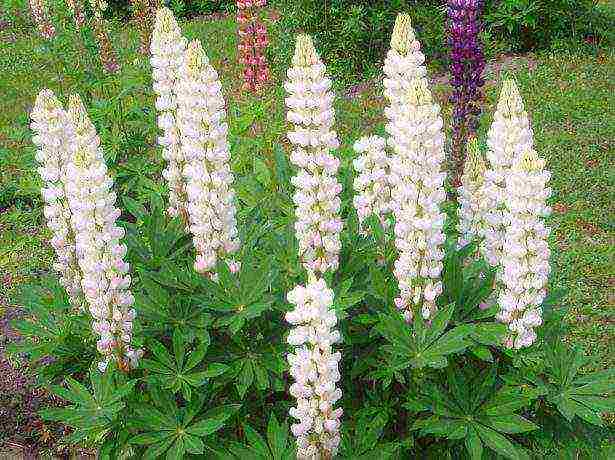
White lupine is more thermophilic than, for example, blue lupine, but it serves as good food for cows.
Blue or narrow-leaved
Lupine blue is much more unpretentious than the previous variety - it easily tolerates low temperatures and even frost, does not require maintenance. Despite the name, inflorescences can be not only blue, but also pink, lilac and even white. It is not as tall as the white variety, reaching a maximum of one and a half meters in height. There are such varieties of narrow-leaved lupine as Crystal, Smena, Nemchinovsky blue and many others. They are also suitable for growing as a fodder crop, but they are especially successful in the role of green manure. And there is a variety that is called Siderat 38. It is known for being a live fertilizer due to special substances in the roots.
It is blue lupine that is primarily used as a green manure, because it grows very quickly, is not afraid of cold weather, takes root deeply and saturates the upper layers of the soil with nitrogen, while loosening them.

Blue lupine is one of the most unpretentious, it perfectly fulfills its function as a siderat
Yellow
The next variety is yellow lupine. It is even smaller in height (maximum one meter) and, unlike white and blue lupines, is cross-pollinated, not self-pollinated. The inflorescence is yellow or slightly touched by orange. It is not so resistant to cold weather, although it can withstand light frosts. It manifests itself best in warm conditions. It must be planted on sandstone and sandy loam. Among the famous varieties are Fakel, Peresvet and Grodno 3.
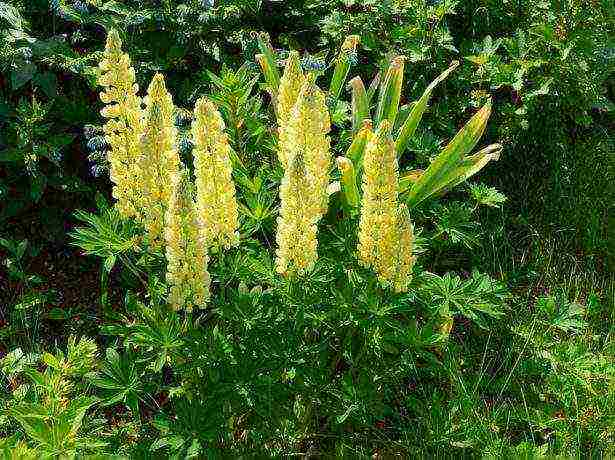
Yellow lupine is cross-pollinated, that is, it needs pollinating insects
In addition to all the listed types of lupine, you can use a perennial variety, otherwise called a multi-leaved one. It is also rich in alkaloids and can easily survive the winter. Therefore, if you want to give some part of your garden a rest for a long time, multi-leaved lupine will be very useful.
Video: annual lupine (green manure)
How to plant a plant?
Lupine is quite undemanding to the composition of the soil, but still heavy loams and peat bogs are not suitable for it. Before planting this crop, loosen the soil, remove all plant debris and start planting. Lupine does not require the introduction of nitrogen-containing fertilizers, which will negate its beneficial properties. Despite the good resistance to frost of most varieties, planting is carried out in the second half of May, when the probability of a strong drop in temperature is no longer as great as at the beginning of the month.
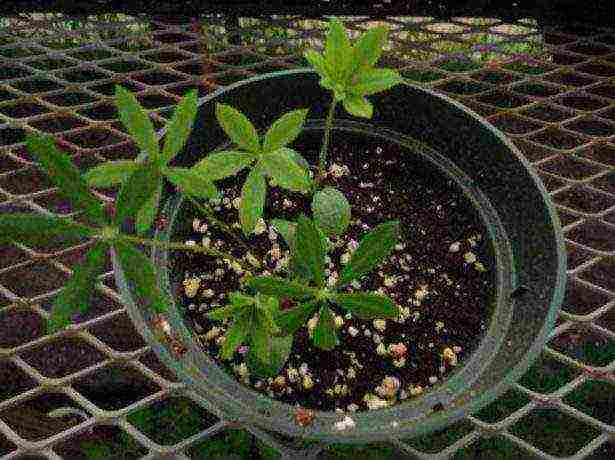
At first, lupine grows slowly, but then it makes a sharp jerk and begins to displace other weeds from the site.
The lupine planting scheme is very simple - the seeds must be sown to a depth of 3 - 4 cm in narrow grooves, between which they leave 20 cm each.The average distance of 10 cm is maintained between neighboring plants.These indicators are averaged and can increase or decrease depending on the size plants inherent in a particular variety.
Try not to plant seeds as close to the surface as possible - they have a very hard shell that is much better removed when germinating from a good depth. If the sprout tries to break through from a depth of less than 2.5 - 3 cm, then it may not shed the shell, and then the cotyledonous leaves will not develop normally. To make the life of the plant easier, cut the shell of the seeds - this is called scarification.
Finding lupine seeds is easy, just contact the nursery where this plant is grown, or find information on the Internet. The price per kilogram is usually low, so planting the site will be cheap.
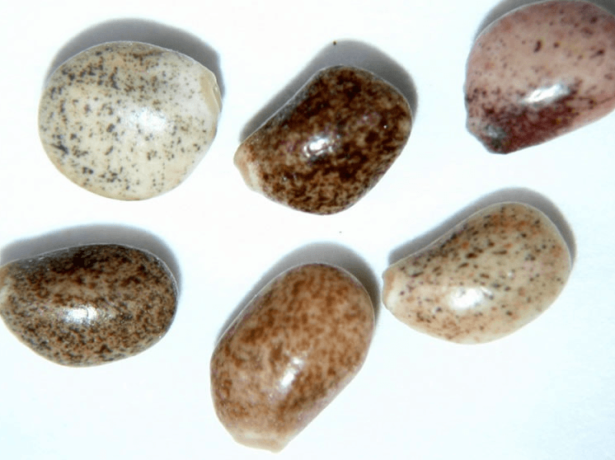
Lupine seeds have a hard shell that can be cut to make germination easier
Siderat care
Actually, caring for lupine does not present any difficulties, since this plant easily assimilates virgin areas, the soil would be suitable. To ensure the most beneficial effect from growing green manure, lupine is mowed two months after planting. Usually at this time he already has time to bloom and acquires green pods. Digging up the beds with lupine is not required. It is enough to mow the green mass, chop the roots with a flat cutter and sprinkle it all with earth. If it happens in dry weather, then watering the beds is mandatory. It would be appropriate to use drugs with effective microorganisms that can be replaced with herbal infusions.
If for some reason you delayed harvesting the lupine, then the mowed stems are best sent to compost, since they will no longer decompose so well in the ground.
Lupine narrow-leaved is often planted before the onset of autumn, in the second half of August. It manages to grow quickly, and already at the end of October it can be mowed and slightly dug in. You can also leave the cut lupine on the surface of the beds until next season.
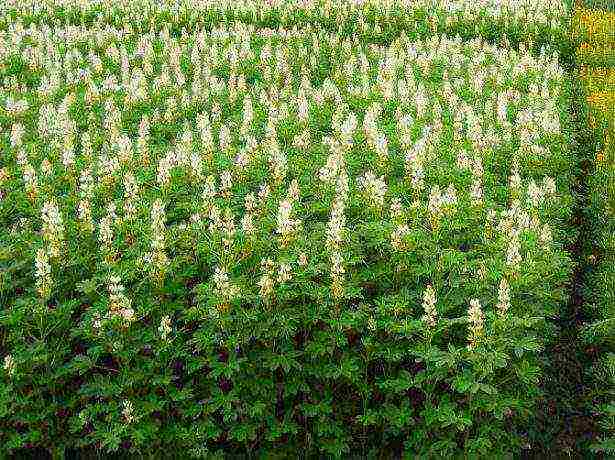
Lupine grows to the desired state in just a couple of months, which allows it to be planted before autumn (blue lupine)
Interaction with other cultures
Lupine itself is full-fledged as a green manure, and it makes no sense to grow it together with other plants of a similar purpose. Otherwise, you can get on the site a struggle between plantings for better conditions, and the result of your event, most likely, will not be as good as expected.
But planting lupine in the aisles when growing vegetables is a very good solution. In this case, all three types of lupine are also used, but white is the best among them. Remember to only water it at least once a week.
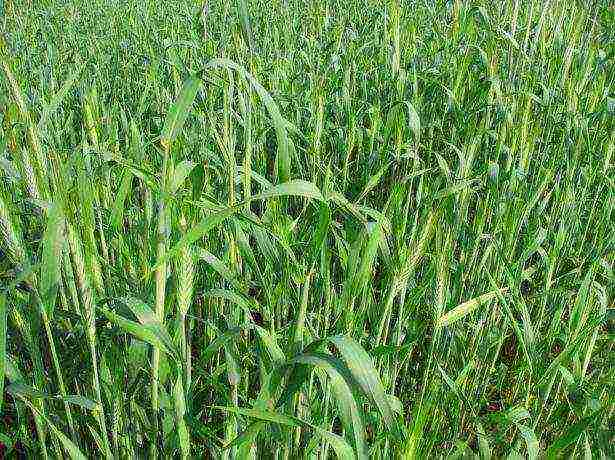
If you plant rye in front of the lupine, this will save the grower from the problem of competing weeds.
In the place where lupine was grown, nightshades (tomatoes, potatoes), peppercorns, crucifers (various types of cabbage, radishes, turnips), pink (strawberries, garden strawberries, strawberries) feel great. You should not plant legumes here, since belonging to the same family determines the presence of common pests and diseases.
Possible difficulties in growing
It would seem, what could be easier than growing a weed on your site that feels great in the wild and reproduces at a high speed? However, often in the garden and vegetable garden, he may suddenly stall and not justify expectations. But everything has its reasons.
First of all, make sure to grow lupines in acidic or at least neutral soil. It will not grow on alkaline, so be sure to measure the acidity level of the soil in your area, and then it will become clear whether it is worth using lupine as a green manure.

Before planting lupines, make sure your area is acidic and not alkaline.
In the first days and weeks of growth, lupine develops slowly and begins to drown in weeds. However, do not rush to get upset, because as soon as he grows, no weeds will be a hindrance to him. It is a good idea to plant lupines after winter rye or wheat, which are famous for their weed-suppressing plants.
Reviews of gardeners and gardeners
The best green manure on clay and loamy soils is the narrow-leaved lupine variety Siderat 38, bred by the All-Russian Research Institute of Lupine. For a couple of seasons of planting and plowing, the clay soil turns black. Moreover, it is not as tall as other varieties.
Yes, we have the same lupine tightened all the fields! BEAUTIFUL! And as he amusingly shoots his seeds away from him, the halves of the pods, when opened, curl up into a spiral instantly and the seeds scatter in different directions, this is how he captures the territory. I collected seeds and tried to sow like green manure in a vegetable garden - it sprouts very slowly and poorly, the weeds sprout much faster, so I gave up this venture with lupine.
We have lupins growing near the gate, my wife does not like them because of their aggressiveness, but I, on the contrary, like them, they bloom beautifully, rarely get sick, from early spring to late autumn they are green, now they are very similar to mini-palm trees, a kind of ikebana ...
And you can fight against their aggressiveness, after the fruit set, cut off the inflorescences, a week later flowers will appear again, which, after the fruit set, cut off again, etc. Thus, the flowering of lupines is extended by at least a month.
Lupine as a siderat has long established itself from the best side. And do not be afraid of stories about its ability to multiply and spread rapidly and irrevocably. Of course, perennial lupine is capable of this, but by taking annual varieties to your "service", you can avoid this problem and give your land the opportunity to rest and replenish the supply of nutrients. And at the same time, admire the beautiful flowering of lupine.
I love the nature and beauty of the world around me, I highlight this in my articles and try to contribute to the implementation of the beautiful into life. Rate the article:
(4 votes, average: 5 out of 5)
Lupine belongs to the legume family and has been cultivated by humans for thousands of years. There is information that the first lupine seed was purposefully thrown into the soil four thousand years ago. Its seeds contain half of the protein and about a third of the oil. Animals eagerly eat both seeds and the entire aerial mass of lupine, from which they quickly gain weight and rarely get sick.
A field sown with yellow lupines
At the moment, about two hundred species of lupine are known, but in our country only four species are grown in culture, including as green manure.We will talk today about three of them - annual species.
Why is lupine good for soil?
In addition to preserving biomass, when plowing or digging, improving the structure of the soil, turning it from coarser to looser, lupine, among other things, collects nitrogen in the soil that is ideal in terms of availability, and in such quantities that sometimes an additional introduction of this element does not not required. Given these purely positive properties for the soil, lupine is very often considered and grown precisely as a green manure, which improves the structure of the soil.
The genus itself Lupine, or wolf bean (Lupinus) contains herbaceous plants, these are both annuals and perennials, as well as shrubs and shrubs. Lupine has a rather powerful and highly developed root system, so it can absorb a large amount of nutrients into its biomass from the depths of the soil and grows well without watering on almost any type of soil. Just think: the central root of a herbaceous plant can penetrate to a depth of two meters. The nodules themselves, which contain nitrogen-fixing bacteria, are located higher, they only do what they take in air nitrogen and transform it into bound forms.
Nodules of nitrogen-fixing bacteria on the lupine root
As a green fertilizer, or green manure, which sounds more scientifically, annual lupines are used. Why? Much depends on the speed of their development, they grow, accumulating nodule bacteria in the soil and increasing the vegetative mass, very quickly. In addition, in just a few seasons, perennial lupins can turn into real weeds, which only heavy equipment can rid the site of, which does not happen with annual lupins.
Usually cultivated as a green manure, probably more familiar to many lupine white, as well as lupins angustifolia and of course lupine yellow.
Reproduction in lupine is seed, the seeds usually ripen in beans, they bizarrely vary in shape, color, size. Thanks to the work of our scientists, the world has learned that there is a direct connection between the color of the lupine flower and the color of the seed skin. After this was found out, it became easier to select lupines for sowing: after all, white seeds are found in flowers with white petals, and blue and purple petals - in plants whose seeds are painted in dark colors. Lupine seeds are no larger than a regular pea in size.
Benefits of using lupine as a green manure
So far, we have only casually mentioned the benefits of lupine as a siderat, and now we will talk about this in more detail. At its core, this is almost the cheapest and one of the most effective ways to change the structure of the soil for the better. In addition, the lupine plant itself, which has many positive properties and qualities, also brings benefits. For example, the most powerful root system, which we have already mentioned, is able to literally dissolve monohydrogen phosphates and thus raise them into higher soil layers accessible to other plants. Lupine, with its powerful and wide root system, perfectly loosens even highly compacted soil and literally feeds it with nitrogen.
It is believed that lupine is just an ideal green manure for soils that are poor in nutrients and have high acidity (although not every lupine will grow normally on such soils), and for soils of sandy loam, that is, excessively loose and empty. Alkaloids contained in the biomass of lupine, after plowing and preserving it in the soil, even if not very quickly and not so actively, nevertheless contribute to the deoxidation of the soil, and with prolonged cultivation, the substrate often even takes on an alkaline form.
These same alkaloids present in lupine suppress the activity of the wireworm in the soil, and when grown in a permanent place, the wireworm, along with the harmful microflora, can disappear altogether.
Due to the fact that after growing lupine, all of its green mass is embedded in the soil and, rotting, turns into an excellent green fertilizer, and even enriches the soil with nitrogen, in areas where crops are grown after green manure, the yield is noticeably increased. And the most interesting thing is that due to the active growth of one-year-old green manures, the result can already be obtained a little more than a month after their sowing. If we take into account all this that the crops of lupine practically do not need care, then it turns out that this is just a fairy tale, and not a plant.
Field planted with annual green manure lupines
Types and varieties of annual lupine
Annual lupine, as we have already mentioned, is successfully used both in fodder and green manure culture. There are now about 20 varieties of lupine in the State Register, so there is definitely something to choose from.
Scientists have found that lupine, during its growth, for its own protection, produces a significant amount of alkaloids, that is, nitrogen-containing substances that protect their host (plants), and these, in turn, quite effectively inhibit and can even suppress the development of various pathogenic bacteria, kill the nematode , get rid of root rot.
White lupine (Lupinus albus)
It is very drought tolerant and does not require pollinators, but adores warmth. This lupine cannot be called a baby, it can easily stretch two meters, and the length of its inflorescences reaches three tens of centimeters. As soon as flowering is over, its fruit (bean) immediately begins to form, each of which contains from three to six snow-white, cuboid seeds.
Varieties are most often used as a green manure. Desnyanskiy 2 (this is a more improved variety from Desnyanskiy, which was obtained back in 2003), and Gamma and Degas... The remaining eight varieties, which are included in the State Register, are also good, but they usually go to feed livestock, because they accumulate very little or do not accumulate alkaloids at all. White lupine has, however, a drawback: it loves constant loosening of the soil, poorly tolerating the soil crust and will not refuse fertilizing with potassium sulfate (10-15 g per square meter 2-3 times with incorporation into the soil).
Lupine narrow-leaved (Lupinus angustifolius)
It is also a plant that does not require pollination, but a lower one and a half meters is the limit for it. Despite the fact that they call it blue, the inflorescences of this lupine may well be pink, pale white, and of course, purple and actually blue. The seeds are often round, but if they sell you barrel-shaped seeds, don't be alarmed, they can be that too, which is perfectly normal. The main thing is to take a closer look at the seeds, they should have something resembling a marble pattern. Lupine narrow-leaved as a green manure crop is often used, it is surprisingly unpretentious and winter-hardy, grows quickly and does not require additional feeding.
Most often, its varieties are used as siderates: Siderat 38, Benyakonsky 334, Pink 399, Benyakonsky 484, Nemchinovsky blue, Knight, Crystal, To snow, Rainbow, Belozerny 110, Hope, Change, Narrow-leaved 109 and others. Often these varieties are used as green manure and are used as feed for farm animals because of their high nutritional value. The only exception is the variety Siderat 38... The fact is that during its cultivation, an interesting fact was discovered: in the roots it contains derivatives of ethyl alcohol and, for obvious reasons, such plants do not go to livestock feed. However, when grown as a green manure crop, this variety simply has no equal, it grows actively, and noticeably quickly increases both the aboveground mass and the root system. If we compare yellow lupine and this variety, then we can highlight clear advantages over resistance to cold weather, including in the late spring periods. It can grow on highly acidified soil types, gradually neutralizing them year after year.
It is also interesting and very valuable that this type of lupine takes more nutrients from the lower layers of the soil, therefore, in fact, you do not need to wait for the complete decomposition of the vegetative mass after plowing, there is enough nutrition for the plants in the upper layers of the soil.
Yellow lupine (Lupinus luteus)
This plant is a typical "crossroads", not high, usually no more than a meter in height. Its inflorescence resembles a spikelet, yellow or light orange in color. Fully ripe beans sometimes contain up to five beige seeds, less often with a small speck, which many mistake for a disease.
If we compare this lupine and narrow-leaved lupine, then we can say that yellow is much more thermophilic, so even in order for its shoots to appear, it needs at least 12 degrees of heat, although it can endure recurrent frosts, having withstood from four to six degrees of frost. This lupine also needs watering, at least once a season in the amount of a couple of buckets per square meter of soil, and lupine will grow better on sandstones and sandy loams, improving them. Most often, these varieties of such lupine are grown here - Gorodnensky, Siderat 892, Academic 1, Kastrychnik, Motive 369, Torch, Prestige and Peresvet.
White lupine (Lupinus albus) Narrow-leaved lupine (Lupinus angustifolius)
Growing annual lupine
So, we have already told enough about lupine as a culture, we move on to the rules for its cultivation and use.
The most diverse, but on very heavy, consisting of only one clay, and on sour peat bogs, lupines will still not grow.
Before planting lupine seeds, the soil must be dug up onto a full bayonet of a shovel and leveled. As for fertilizers, at the initial stage, even if the soils are very poor, I would not recommend applying either nitrogen fertilizers or organic matter. The fact is that nitrogen-fixing bacteria begin to develop themselves immediately after the start of plant growth, but excess nitrogen, even in the form of organic matter, will not only not help this process, but, on the contrary, inhibit it.
Sowing green manure crops, in particular - lupine, is usually started in late spring, often in the second half of May, when the soil has already warmed up enough, and there will be no risk of significant return frosts.
The planting technology, or rather, sowing, is very simple: all that is needed is to dig well, level the soil, make grooves (three centimeters deep), with a distance of about 20 cm between them, and try to place seeds in them in such a way that between each distance equal to 9-12 cm (depending on the vigor of plant growth). The standard consumption of lupine seeds per one hundred square meters of land in a standard garden is about three kilograms, although if the seeds are small, then it can be smaller.
If the seeds have been stored for a long time (a year or more) or you do not know the exact shelf life, then in order for them to grow together and quickly, it is better to scarify them, that is, slightly damage the shell of each seed. Do not think that in fact all this is so simple, the shell of the lupine seed is quite tough, probably more than once you have observed how the sprouts that have climbed to the surface cannot free themselves from the cotyledon, so you need to be more careful and not get hurt yourself. Usually a couple of neat cuts with a clerical knife or by holding the seed on emery, the finest paper, are enough to speed up their germination.
The use of annual lupine as a green manure
After sowing lupine, it is important to remember that this is a green manure culture, that is, it is aimed at improving the soil structure of your site, and not your site itself, therefore, you need to take care of it accordingly. Usually, a couple of months after the start of growth (no later), the plants are mowed and well dug up with the turnover of the layer. It is not always possible to do this with a shovel or scythe.Often they resort to the help of a walk-behind tractor for this, first cutting the roots with a flat cutter, and then digging up the soil, thoroughly mixing the green mass with it.
Further, the site must be left alone for a couple of months so that the green mass decays and is ready for planting other plants on it. In the event that the weather is dry, then once a week you can water the site, spending a couple of buckets of water per square meter, or use an infusion of herbs of conventional preparation or any of the EM preparations.
If, with the transformation of lupine into green manure, it is late and the pods full of beans become dark, then it is easier to mow all the green mass with an ordinary mower and lay it in a compost heap. Why? Yes, just at a more mature age, the stems of lupine become so dense that they will decompose in the soil for a long time.
Before embedding in the soil, lupine blue takes only 55-60 days from sowing, taking into account this, it is quite acceptable to sow it in the fall, followed by embedding in the soil in the fall. Blue lupine is sown immediately after harvesting the main crop from the garden, which usually occurs in the second decade of August, and already at the very end of October, preferably before the onset of frost, this green manure can be mowed.
In this case, the green mass, of course, does not need to be embedded to a great depth, it will be enough just to mix it with the soil. For those gardeners who do not have the opportunity to mix the grass cut in the autumn with the soil, they can simply mow it and leave it on the soil surface until the beginning of the spring period.
What grows best after green manure?
In the field, which was under green manure grasses, potatoes, tomatoes, bell peppers, strawberries and cabbage grow best of all, representatives of the legume family grow worst of all, and mainly due to the presence of common pests in both.
Advice. According to my own observations, it is better to keep the aisles of the garden not under black steam, as is often the case, but under lupine, that is, also under turf. For these purposes, white or blue lupine is best suited, but do not forget about additional watering and remember that after mowing green manures in the aisles of the garden, they do not need to be embedded in the soil, it is better to just cover the ground with them, creating something like a mulching layer.
Sown like green manure lupine angustifolia
Why does lupine grow poorly?
In conclusion, I would like to answer one of the most frequently asked questions - why does the lupine on the site not want to grow in any way. We answer - the first reason is usually the acidity of the soil, as we already wrote, not all lupins develop well on acidic soil, and blue lupine generally does not want to grow on alkaline soil.
Advice - be patient a little: at the initial stage of its development, lupine grows rather slowly, for example, large industrial farms use this, sowing it under oats, winter crops, annual grasses, and after mowing their green mass, lupine also begins to actively develop. So you can get a couple of crops in one field.
And in order not to win back lupine from cereals, try to plant it after winter cereals, so they just slow down the growth of weeds thoroughly!
Still have questions? - we are waiting for them in the comments!
Siderata are plants that are grown before planting the main crop to enrich the soil with useful elements. They are restore humus reserves, improve the structure, increase the fertility of the upper arable layer.
These plants are undemanding and cold-resistant, therefore they can be planted even in early spring and autumn. In some regions of the country, green manures are planted in early October, and before the onset of cold weather, they manage to increase the necessary green mass. There are many ways to use this "green fertilizer". This type of plant reduces the acidity of the soil, helps to accumulate useful macroelements in the upper horizons, and accelerates microbiological processes.
Siderata are planted for:
- Fertilizing the soil;
- High-quality structuring of the soil layer;
- Shading young plantings;
- Cleaning the land from weeds;
- Protection of plants from insect pests;
- Restoration of eroded soil.
Features of the use of green manure
If you do not know how to use "green fertilizers" correctly, you can make a number of mistakes that will negate all your efforts.

In order not to be disappointed in this method of enriching the soil with useful substances, it is advisable to adhere to the following rules:
- Siderata must be mowed on time, otherwise the stems will coarsen and will rot for a long time in the ground. Semi-rotten biomass can become a source of viral and fungal diseases.
- It is not worth waiting for the plants to grow to their maximum volume. Excess nitrogen in the soil can cause the roots of the next crop to “burn”.
- To protect the beds from weeds, green manure must be sown in bulk, not in rows.
- You need to cut the tops of these plants two weeks before planting the main crop.
- Plants belonging to the same family as green manure should not be planted next to them, as common pests could have survived in the ground.
- If the goal is to restore the soil, then "green fertilizers" must be cut off with an oblique or flat cutter, without damaging their root system.
- Do not mow winter green manures planted in late autumn before freezing. Leave them until next spring. In this case, you will not have to plow the land, it will be very loose anyway.
The technology of soil improvement with the use of vermicompost is increasingly being used in private gardens and in large agricultural holdings. It includes many different points, but the main principles of this concept are respect for the land and the use of plant fertilizers.
The most common green manure plants are white mustard, rye, oats, lupine, phacelia, vetch and rapeseed. The features of the use of each of them will be described below.
Phacelia
The biggest advantage of this siderat is that any culture can be planted after it. Phacelia belongs to the gimlet family, to which none of the cultivated plants of the middle lane belongs. It can be sown before and after any vegetables, grains and herbs. Application rates - 8-10 g / sq. Due to its "class affiliation", this plant is suitable for fertilizing lands for cabbage, radishes, turnips, as they are more often than others affected by pests.
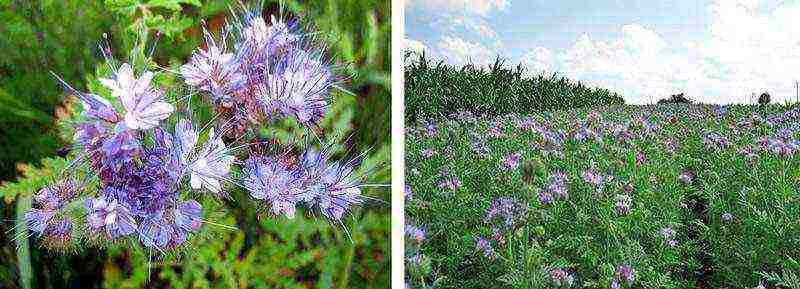
Phacelia emerges and develops very quickly (45-55 days), forming lush bunches of greenery growing from one root. It got its name from the shape of the aboveground part, since in Latin, Phacelia is a bundle. Outwardly, she looks very attractive. Purple flowers and carved leaves look decorative and will be appropriate for filling empty spaces in flower beds, flower beds and high ridges.
Phacelia embedded in the soil increases its fertility no less than cow dung. The introduction of tops into the soil (about 100 kg / one hundred square meters) is equivalent to using 1 ton of humus on the same plot of land. But it is possible to prepare plant biomass much faster, and it will cost less than organic fertilizers of animal origin.
Another very useful property of this flower, which is not found in other plants belonging to the conventional class of "green fertilizers" - its nectar attracts entomophages that destroy pests. Moths, aphids and leafworms disappear from the garden plot. Phacelia is often planted as a protective barrier for potatoes in order to protect the planting from pests. The wireworm does not tolerate the neighborhood with it, and locusts and soil nematodes simply die when the fungicides secreted by its flowers are inhaled. At the same time, this flower does not have a negative effect on bees, and is an excellent honey plant.Some beekeepers specifically plant phacelia in whole plantations in order to obtain flower honey with excellent taste.
How to grow phacelia seeds?
 Phacelia is the best green manure in terms of versatility. Therefore, many summer residents want to see her on their site. But her seeds are expensive. And one of the most important advantages of using bio-humus is the low cost of use. If this factor is offset by the high cost of seeds, then there is no point in sowing this plant.
Phacelia is the best green manure in terms of versatility. Therefore, many summer residents want to see her on their site. But her seeds are expensive. And one of the most important advantages of using bio-humus is the low cost of use. If this factor is offset by the high cost of seeds, then there is no point in sowing this plant.
Many summer residents have learned to bypass this obstacle by growing seeds on their own. To do this, leave a plot, away from the garden, so that the ripening seeds are not poured into the beds. Then they wait for the flowers to fall off most of the spikelet. The stems are cut and dried in a closed, well-ventilated place with low humidity. A well-dried phacelia is threshed, and an excellent seed material is obtained, in no way inferior to store counterparts.
Mustard white
This cold-resistant green manure can be grown and buried several times per season. The last time it is planted before winter, a few weeks before the onset of cold weather. This is done so that the green mass is "beaten" by the cold, and it would remain to rot under a layer of snow. The decay processes will continue for some time, after the onset of negative temperatures, due to the internal heat released during the decomposition of plant organic matter. It is enough to turn green manure fertilizers into humus, which will be very useful for plants in spring.
Mustard grows amicably, and very quickly gains vegetative mass. It is very important not to "miss" the moment when the stems begin to harden. Greens must be mowed until they turn yellow, before the first flowers appear, as soon as the first ovaries of buds have filled.

The minimum period from sowing to embedding of this plant in the soil is five weeksbut, if possible, it is better to wait all eight. When calculating the timing of harvesting, it should be borne in mind that in hot weather, the stems harden faster, in cold weather - slower, so in autumn and spring you can leave greens in the beds for a long time.
Mustard is usually sown "randomly", with the exception of those cases when it is used to protect plants from pests. Then the in-line method is applied. The seed consumption rate of this fertilizer is 4-7 g per 1 sq. If you sow more, then the plantings will thicken, and rotting of greenery on the vine may begin.
To accelerate the maturation of vegetable humus, the green mass obtained from mustard plantings can be watered with a biostimulant. For this purpose, Baikal is perfect, which is diluted in a ratio of 1: 1000 (a drop per liter of water), and the mowed grass is sprayed with the solution with a spray bottle. Under the influence of live bacteria contained in the preparation, the grass rot faster and becomes part of the soil system.
Video: mustard and other siderates - planting and result
Lupine
Common lupine is considered one of the oldest green manures in the history of agriculture. To enrich the soil, poor in nitrogen, it was used in Greece, more than two thousand years ago. Gardeners completely buried the trunk and leaves without roots in the near-trunk circle of a fruit tree, and there was enough nitrogen for that for several months.
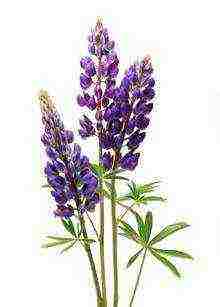
This plant belongs to the legume family, respectively, beans, peas and beans cannot be planted after it, these crops have common pests. Tomatoes, cabbage, peppers will be excellent followers for lupine. And for potatoes, this beautiful flower will be the best predecessor.
The powerful roots of the plant are an active leavening agent, penetrating deeply into the soil. In parallel, they have another positive effect - they saturate all soil horizons with nitrogenous bacteria. Lupine plantings are capable of accumulating about 200 kg of nitrogen per hectare in the ground.
This green manure is planted in early spring, in a row method.Seed consumption (and they are quite large) - 4-5 per sq. When the lupine reaches the age of 5-7 weeks, its tops are plowed into the ground. Even if it bloomed, this is not scary, the most important thing is to prevent the formation of seeds, since at this stage of plant development, the stem becomes tough and does not rot well in the soil.
The great advantage of the plant can be considered a tap root system., which goes deep into the ground, and receives most of the nutrients from the deeper layers, without depleting the upper fertile layer. At the same time, vermicompost, obtained from the aerial parts of lupine, per 1 sq. M. replaces 4 kg of manure, or 40-50 g of urea.
Rye
In many regions of the country, it is customary to sow the garden with this cereal after digging up potatoes. The rye bushes well, and builds up a large green mass, reaching 200-300 kg per hundred square meters. This green manure is planted both in winter and in spring, the planting time does not affect its quality. The special value of winter rye is that it actively builds up biological mass even at rather low temperatures, and winter crops survive even in snowless winters, with frosts down to -25 ° C.
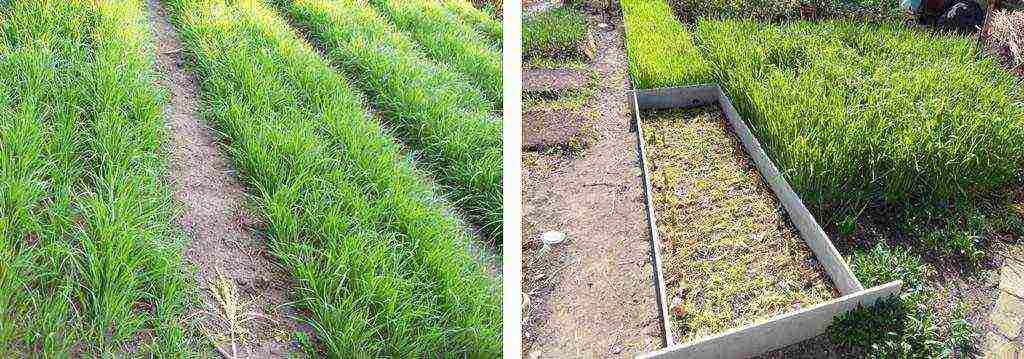
The downside of all cereals grown to enrich the soil, including rye, is the complexity of their subsequent processing and plowing. The stems have a fairly strong structure, decompose for a long time, and cling to the plow shares, which have to be cleaned all the time. Another disadvantage of this winter green manure can be considered that it dries up the soil greatly, so it is impossible to sow rye in the garden between the trees.
Otherwise, this cereal is an excellent fertilizer, the seeds of which are inexpensive and therefore available to everyone. Rye is undemanding to the quality and thickness of the soil layer, perfectly grasses loose soils, easily tolerates high acidity. Since this plant has a fibrous root system, it easily retains nutrients in the upper soil horizon, preventing them from being washed out with melt water and rainwater.
The big advantage of this fertilizer-green manure is that decomposing, it saturates the soil not only with nitrogen, but also with calcium. Microorganisms contained in cereal biomass create conditions for the absorption of difficult-to-digest phosphorus compounds, dissolving them. Accordingly, a complete NPK-complex of nutrients remains in the ground, which allows any culture-followers to fully develop.
The aboveground part of cereals after cutting is used not only for plowing. The resulting straw is used as mulch. It provides excellent protection of the soil from drying out, and does not allow weed seeds to break through to the surface. Subsequently, decomposing, fresh straw becomes part of the garden bed, turning into vermicompost.
Oats
This cereal crop is used as green manure less often than rye. But this is more an accident than a pattern. The plant has all the positive qualities of rye, while it also wins over it in some parameters. For example, oats are even more unpretentious. It can be sown on acidic podzolic soil, clay, and even peat - it will grow everywhere.

Green oats combined with clover
As an element of crop rotation, it is sown after legumes, preparing the land for potatoes. Despite the apparent weakness of the fibrous root system, this plant perfectly loosens the earth to a great depth, enriching it with oxygen, and creating a structure that is comfortable for cultivated plants. Oats saturates the upper soil layer with nitrogen and potassium, and, like rye, decomposes difficult-to-digest phosphorus compounds.
The seeds of this culture are planted, scattering them over the surface of a previously loosened plot of land, in early spring, as soon as it will be possible to enter the garden. Do not be afraid of dirt and cold - oats love them, and these parameters do not affect its germination.On the contrary, in late March - early April, optimal conditions are created for the germination of oats, since they can feed on soil moisture from the melted snow. The seeding rate is 1.5-2.1 kg per hundred square meters, the seeding depth of seed is 4-5 cm.
Growing potatoes in oats
Agricultural technologies, like any others, do not stand still. In modern horticulture, the technology of growing crops without prior plowing of the land is increasingly being used. It allows you to save not only energy and time, but also to get excellent harvests. Siderata, as part of a crop-free farming culture, are actively used in this system.
Oats can be not only a supplier of vermicompost. His can be used for potatoes by growing tubers in oat straw mulch. Moreover, on the plot, which is planned for this culture, you do not even have to remove the grass, it will disappear by itself, passing into the composition of the nutrient soil. It is only necessary to slightly push it apart, and in between to make grooves in which oats are planted.

When the siderata and weeds grow up enough, they are mowed under the root with a flat cutter, and, having made a small depression in the soil, they plant a potato there, lightly sprinkling it with a layer of earth. The sprouts that appear are mulched with straw and grass, and when they become very large, they gradually add other green waste, for example, the grass left after mowing the lawn. Most importantly, it is necessary to block access to the tubers of the sun's rays, which will "green" them, making the potatoes unsuitable for human consumption.
After the autumn harvesting of potatoes, which, by the way, will become a very clean and quick process, the field must be sown with oats again, and continue to do this every year. In a couple of years, without digging, the soil structure will be completely restored, and this plot of land will give consistently high yields.
Vika
Vetch (mouse pea) is an early ripening plant, and has a short growing season, which allows it to be used as an intermediate crop between plantings of major crops. For example, it can be planted in beds intended for seedlings of tomatoes, peppers and eggplants. It can also be sown in front of melons and gourds. Pumpkin, zucchini, squash, planted "on vetch", give excellent harvests.

Planting of green manure is carried out throughout the growing season, as soon as temperatures above zero are established. Sowing rate - 1.5 kg per one hundred square meters. The seeding depth is 1-3 cm. It is not necessary deeper, otherwise the plant will not be able to penetrate the surface layer of the soil. To accelerate the emergence of seedlings, the plot can be watered with EM fertilizers, it is cheap and fast.
Vetch is often included in a mixture containing green manure plants such as rye, oats, rapeseed and ryegrass. This is done to obtain the optimal composition of vermicompost, which is formed after mowing these crops, since this plant accumulates mainly nitrogen. "Mouse peas" belong to the legume family, and, accordingly, has a similar structure. On its roots, the same nitrogenous nodules are formed, which accumulate this element. Peas, beans and beans should not be planted after it. But potatoes, cabbage, radishes, cucumbers and greens will be excellent follow-up crops.
Donnik
Previously, this herb was used as a fodder crop for livestock. But then they noticed that when plowing the fields where the sweet clover grew, the land gave richer yields than in the fields that were sown with other grasses. After that, the sweet clover began to be used as a green manure. It is a biennial plant that is grown as an annual. Melilot is unpretentious, hardy and grows quickly. It belongs to the legume family, so it can accumulate nitrogen in the root system. Its roots penetrate deep into the ground, and have a large number of branches. Thanks to the powerful root system of this plant, there is no need to dig up the ground after cutting it.It will be loose without additional processing.

A feature of the cultivation of sweet clover is that the most useful is not the aboveground, but the underground part. Therefore, you can cut the plant in 3-4 weeks after germination. If you let it outgrow, it will become too hard for further processing, and the "pipes" from its stems will stick out of the garden for a couple of seasons, not decorating the garden at all.
Radish
Oil radish is a unique green manure with a rapidly growing aerial part. In 6-7 weeks, it can increase its vegetative mass by 4-5 times. It is popular among gardeners as a natural "agrokiller". Radish suppresses all weeds, even creeping wheatgrass.
 This green manure is not only an active supplier of biomass. Radish is a natural doctor and earth cleaner. It successfully fights diseases such as cabbage keel and nematode. It must be planted on lands that have been affected by various diseases and insect pests for several seasons, and the soil will become healthy again.
This green manure is not only an active supplier of biomass. Radish is a natural doctor and earth cleaner. It successfully fights diseases such as cabbage keel and nematode. It must be planted on lands that have been affected by various diseases and insect pests for several seasons, and the soil will become healthy again.
It is best to sow radish on fresh plowing; it loves soft soil. Seed consumption - 300 g per hundred square meters. 4 weeks after the emergence of full shoots, the aerial part of the plant is excised with a shovel, and dug up together with the soil. The thickest stems are best composted.
***
The use of green fertilizers allows you to restore the soil balance, save money on purchased fertilizing, and grow environmentally friendly products. The use of green manure helps to create a new humus layer, which was destroyed by the use of traditional agriculture, when all the nutrients were taken out of the soil with the resulting products. The soil enriched with natural methods will be transformed, and will certainly thank you for all your efforts with abundant harvests of environmentally friendly vegetables and fruits.
Video: green manure in the country - sowing, collecting seeds, efficiency


